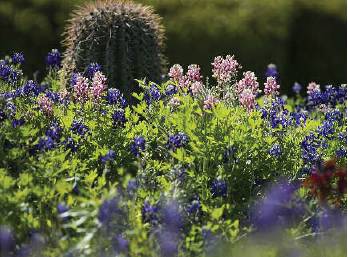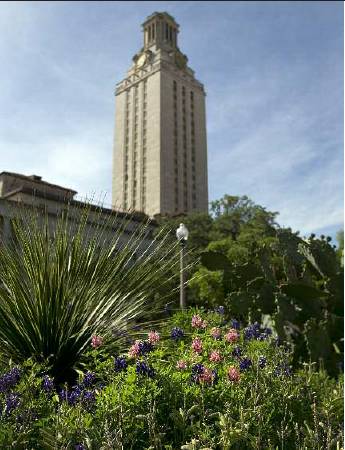|
Maroon Bluebonnet Comes to University of Texas – Austin Campus in 2014
 Some at UT now seeing red — or at least maroon
Some at UT now seeing red — or at least maroon
Bluebonnets with a hue similar to one of Texas A&M’s colors have cropped up on the UT campus. Suspicion abounds about the origin of the plants, with some claiming sabotage.
Can UT get to the root of Aggie-hued mystery?
By Heather Alexander and Allan Turner HOUSTON CHRONICLE
Austin flower lovers are singing the bluebonnet blues — and it’s all because a patch of the beloved state wildflower planted in the shadow of the venerable University of Texas Tower is popping up maroon.
At least some in the land of the Texas Longhorns suspect the horticultural surprise is the dastardly work of UT’s old gridiron archrivals, the Aggies.
“There were just a few at first, but now there’s much more,” Markus Hogue, UT’s irrigation and water conservation coordinator, said of the off-putting blossoms. “Some find it cute. Others say if they get too much, they want them removed.”
Hogue said the maroon bluebonnets likely were created at Texas A&M, and indeed they were. But seeds for maroon bluebonnets — along with pink and white ones — have commercially been available for more than a decade.
“We plant a few acres a year,” said Tom Kramer, a botanist with Wildseed Farms, a Fredericksburg seed purveyor. “They’re just a novelty, something different, a freak of nature,” Kramer said. “Texans never would want to give up their blue bluebonnets.”
 The maroon variety, developed in the 1980s by Texas AgriLife Extension Service horticulturist Jerry Parsons, officially is known as “Alamo Fire.”
The maroon variety, developed in the 1980s by Texas AgriLife Extension Service horticulturist Jerry Parsons, officially is known as “Alamo Fire.”
“They took the red ones and isolated them and continued to select them until there was only maroon left,” explained Skip Richter, a horticulturist with AgriLife’s Harris County office. “ . . . God chose to put a maroon gene in (in the bluebonnet family) but there ain’t no orange one.”
The advent of maroon bluebonnets marks the second time A&M plant experts have irked UT loyalists.
In the late 1990s, College Station scientists commercially developed a maroon carrot — a vegetable with 40 percent more healthful beta carotene than its burnt orange precursor.
For generations, indigo-hued bluebonnets — designated the state flower in 1901 and planted along state highways since 1930
— have been celebrated in poetry, stories and countless family snapshots.
Succeeding growths of nontraditional bluebonnets will cross-pollinate and gradually revert to blue, plant experts said.
But Hogue isn’t ready to wait that long. He and his staff at UT are prepared to lop off the maroon menace’s seed pods as soon as they appear. Better safe, after all, than sorry.
Bluebonnets with a maroon hue grow in flower beds near the University of Texas Tower in Austin. Many wonder if the flowers were planted as a prank by Texas A&M fans.
Deborah Cannon / Austin American-Statesman
Did Texas A&M Prank Texas with Genetically Altered Flowers?
By Kyle Newport, Featured Columnist | April 9, 2014
The Texas-Texas A&M rivalry suffered a major blow when the Aggies left the Big 12 for the SEC, but the rivalry may be continuing to bloom.
Even after Texas A&M left the conference, pranks between the two schools have continued. Now, the Longhorns are left wondering if the Aggies are behind a flower mystery.
The bluebonnet is Texas' state flower, so seeing them on the Austin campus isn't a big surprise. However, seeing genetically modified bluebonnets raises questions, according to KEYE TV's Cassie Gallo.
Texas program coordinator for irrigation and water conservation Markus Hogue said that bluebonnet seeds were planted next to the University of Texas Tower a few years ago. Now that the flowers have started to bloom, the prank war may have heated up. The bluebonnets are maroon, which has left the Longhorns puzzled.
Hogue spoke about the issue, via Gallo:
“It's definitely going to get worse. They are going to keep multiplying. It is just a weird coincidence that the only place that we have them on campus that we know of is right by the tower.”
As of now, the maroon bluebonnets are only by the Tower. However, seeds will start to spread as time goes on and more of the flowers will be present.
In Gallo's report, one Longhorns student is not putting it past the Aggies to pull off a prank like this.
"That wouldn't surprise me," student Cassie Lissak said. "They can't bring the competition on the playing fields so they might as well bring it with their green thumb."
Right now, it's only speculation that Texas A&M is behind the prank. That's enough to drive the people at Texas crazy, but that's what sports are all about.
Aggie Rivalry Continues To 'Bloom' on UT Campus
By Cassie Gallo | Updated: Wednesday, April 9, 2014, 10:51 AM CDT
The State of Texas blooms a sea of bluebonnets, but on the University of Texas campus something is not quite right.
Genetically modified bluebonnets are invading the campus, and rumor has it Texas A&M University is in on the prank.
Markus Hogue is the Program Coordinator for Irrigation and Water Conservation for UT Austin. He said a few years ago bluebonnet seeds were planted in the flower beds next to the Tower, but eventually patches of the maroon flowers started sprouting.
"It's definitely going to get worse. They are going to keep multiplying," Hogue said. "It is just a weird coincidence that the only place that we have them on campus that we know of is right by the tower."
The century old rivalry between UT and Texas A&M has spanned football fields, families, and now even flower beds.
Students like Carly Lissak said they were sad to see the conference rivalry break apart a few years ago, but are not surprised to see pranks continue.
That wouldn't surprise me," Lissak said. "They can't bring the competition on the playing fields so they might as well bring it with their green thumb."
Or maybe bring it with their "Gig-em" thumb, either way these frank-n-flowers are here to stay for the long run.
Right now there are only handfuls of maroon patches, but overtime as seeds spread more and more will pop up everywhere.
If that is the case, some students fear on campus is that one day maroon bluebonnets will take over campus.
"If that were to happen we should just completely remove the gardens," junior student Brandon Arias said.
The prank may have planted its roots in front of the Texas tower, but in the end Longhorns always look for the last laugh, and in the end it is a rivalry that will continue to bloom all the live long day.
UT suspects sabotage after A&M-created maroon flowers pop up near tower
By Heather Alexander | April 10, 2014 | Updated: April 11, 2014 9:48am
President Barack Obama's visit to the University of Texas in Austin could be overshadowed by the emergence of a scandal of potentially epic proportions.
Maroon bluebonnets are taking over flowerbeds below the school's iconic tower. Officials fear their landscape has been infiltrated by longtime rival Aggies.
"There were just a few at first but now there's much more," said Markus Hogue, program coordinator for UT Irrigation and Water Conservation.
Hogue said his team had planted regular bluebonnet seeds all over the campus. It's only in the beds below the tower that the maroon ones are showing, leading him to believe that they were planted there deliberately.
"When we started seeing the maroon, I started researching it more, (that) led me to believe that it was more likely these seeds were created at A&M and brought over here," Hogue said.
Over at the Texas A&M campus, horticulturalists confirmed Thursday that maroon-bonnet seeds were indeed bred by them after researchers spotted a few occurring naturally in the Texas countryside.
"They took red ones and isolated them, and continued to select them until there was only maroon left," said Skip Richter from A&M's agrilife extension center in Harris County.
Richter is just one of thousands of A&M scientists and specialists all over the state, leading some to suggest that they had plenty of opportunity to slip onto the UT campus, perhaps under cover of darkness, to spread their maroon interlopers.
Richter said he didn't know anything about that, but he said it is likely that someone did plant them deliberately.
"Somebody scattered the seed probably," said Richter. "You wouldn't have a bunch of one color sprouting up (otherwise)," he said, undoubtedly smirking.
Bluebonnets also come in white and pink but if they are put with blue ones all would naturally return to blue over time, according to Richter. A Texas flag once created out of different colored bluebonnets has now turned back to blue.
At UT, the opposite is happening. More maroon ones are appearing. It's led to much consternation from some students.
"Some find it cute," said Hogue. "Others say if they get too much they want them removed."
Hogue's team is preparing to stop the rival breed in its tracks by cutting off seed cases with scissors before they can propogate.
At A&M, though, the controversy has led to much hilarity.
Richter said the school also bred special maroon carrots, and is quick to point out that "God chose to put a maroon gene in (the bluebonnet family), but there ain't no orange one."
Texas Bluebonnets
Oh the blue of our Texas bluebonnets,
is food to my weary old eyes.
Deeper than the blue ocean,
and bluer than summertime skies.
Oh how I love the bluebonnets;
no other flower compares.
I’m sure that I’ll see bluebonnets,
at the foot of the heavenly stairs.
-Greg Grant
|
|



